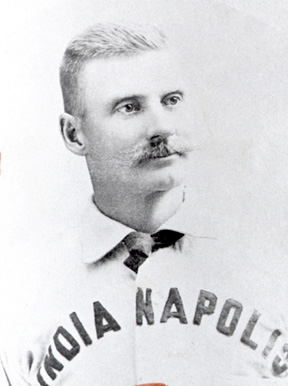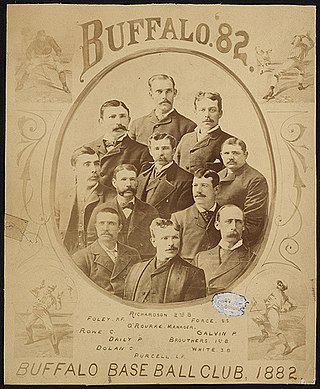Related Research Articles

Edward Hugh Hanlon, also known as "Foxy Ned", and sometimes referred to as "the Father of Modern Baseball," was an American professional baseball player and manager whose career spanned from 1876 to 1914. He was posthumously inducted into the Baseball Hall of Fame in 1996 by the Veterans Committee.

John Wesley Glasscock was an American shortstop in Major League Baseball who played for several teams from 1879 to 1895. Nicknamed "Pebbly Jack", he was the top player at his position in the 1880s during the sport's bare-handed era. He led the National League in fielding percentage seven times and in assists six times; he was the only shortstop to lead in fielding percentage and total chances in a season three different times until Luis Aparicio matched him. Ozzie Smith eventually surpassed Glasscock's marks in the 1980s; Glasscock also led the NL in double plays four times and in putouts twice. He won the 1890 batting title with a .336 average for the New York Giants and led the league in hits twice; in his final season he became the sixth major league player to make 2,000 hits. He was the first player to appear in over 600 games as a shortstop, and ended his career with major league records for games (1,628), putouts (2,821), assists (5,630), total chances (9,283), double plays (620) and fielding percentage (.910) at the position. When he retired he ranked fifth in major league history in games (1,736) and at bats (7,030), seventh in total bases (2,630) and eighth in doubles (313).

William Adam Meyer was an American baseball player and manager. He holds the dubious distinction of having played with, then managed, two of the worst teams in the history of Major League Baseball.

Thomas Tarlton Brown was an Anglo-American center fielder in Major League Baseball. Born in Liverpool, Lancashire, England, son of William Henry Tarlton Brown and Mary Nixon Lewis, he played for 17 seasons, a career in which he batted .265 while scoring 1,524 runs with 1,958 hits. Upon his retirement he served as an umpire, working mostly in the National League in 1898 and 1901–1902.
The New England League was a mid-level league in American minor league baseball that played intermittently in five of the six New England states between 1886 and 1949. After 1901, it existed in the shadow of two Major League Baseball clubs in Boston and alongside stronger, higher-classification leagues.
The Western Association was the name of five different leagues formed in American minor league baseball during the 19th and 20th centuries.

The original Buffalo Bisons baseball club played in the National League between 1879 and 1885. The Bisons played their games at Riverside Park (1879–1883) and Olympic Park (1884–1885) in Buffalo, New York. The NL Bisons are included in the history of the minor-league team of the same name that still plays today; it is thus the only NL team from the 19th century that both still exists and no longer plays in Major League Baseball.
The Middle Atlantic League was a lower-level circuit in American minor league baseball that played during the second quarter of the 20th century.
The Interstate League was the name of five different American minor baseball leagues that played intermittently from 1896 through 1952.
The Utica Blue Sox was the name of two minor league baseball teams based in Utica, New York.
The Connecticut League, also known as the Connecticut State League, was a professional baseball association of teams in the state of Connecticut. The league began as offshoot of the original Connecticut State League, which dates back as far as 1884. In 1891, the Connecticut State League included the Ansonia Cuban Giants, a team made up of entirely African-American ballplayers, including future Hall of Famers Frank Grant and Sol White. In 1902, it was a Class D league with teams in eight cities. In 1905, the league became Class B, which lasted until 1913, when the league became the Eastern Association due to several teams outside of the state entering the league. Also a Class B league, it survived two more seasons, then folded after the 1914 season.

Thurman Lowell Tucker was an American professional baseball player. A center fielder, Tucker played in Major League Baseball for nine seasons in the American League with the Chicago White Sox and Cleveland Indians. In 701 career games, Tucker recorded a batting average of .255 and accumulated 24 triples, nine home runs, and 179 runs batted in (RBI).
The Ohio State League was a minor league baseball league that operated in numerous seasons between 1887 and 1947, predominantly as a Class D level league. League franchises were based in Indiana, Kentucky, Michigan, Ohio and West Virginia.
The Roanoke Red Sox was a primary name of the minor league baseball teams based in Roanoke, Virginia. Between 1894 and 1953, Roanoke teams played as members of the Virginia League and Piedmont League (1943–1953), winning five league championships and one pennant. Roanoke teams were a minor league affiliate of the Cleveland Indians in 1940 and Boston Red Sox from 1943 to 1953. Baseball Hall of Fame members Jack Chesbro (1896) and Heinie Manush (1943) played for Roanoke.
The Springfield Browns was a primary moniker of the minor league baseball teams based in Springfield, Illinois between 1931 and 1950. Springfield teams played as members of the Illinois–Indiana–Iowa League (1931–1932), Mississippi Valley League (1933), Central League (1934), Illinois–Indiana–Iowa League and Mississippi-Ohio Valley League (1950), winning the 1939 league championship. Hosting home games at Reservoir Park, Lanphier Park and Jim Fitzpatrick Memorial Stadium, Springfield teams were an affiliate of the 1931 St. Louis Browns, St. Louis Cardinals (1933–1934), 1935 Detroit Tigers and St. Louis Browns.

Joseph Carl Cambria, also known as "Papa Joe," was an American professional baseball scout and executive who was a pioneer in recruiting Latin American players. From 1929 through 1940, he owned several Minor League Baseball teams, as well as the Negro league Baltimore Black Sox. He is best known, however, for his work as a scout for Major League Baseball, especially for his work in Cuba. From the mid-1930s until his death in 1962, he recruited hundreds of Cuban players for the Washington Senators and Minnesota Twins. Cambria was described as "the first of many scouts who searched Latin America for inexpensive recruits for their respective ball clubs."
The Pawtucket Maroons were an early minor league baseball team based in Pawtucket, Rhode Island. The "Maroons" were part of a Pawtucket tenure as members of the New England League beginning in 1892 and continuing through the 1899 season. Pawtucket teams then played briefly in the 1908 Atlantic League and were members of the Colonial League in 1914 and 1915.
Minor league baseball teams were based in Findlay, Ohio between 1895 and 1941, playing under four nicknames and hosting games in four ballparks. Findlay teams played as members of the Interstate League in 1895, Buckeye League in 1915 and Ohio State League from 1937 to 1941. The Findlay Browns were a minor league affiliate of the St. Louis Browns in 1937 and 1938. Baseball Hall of Fame member Bud Fowler played for the 1894 Findlay Sluggers.
Minor league baseball teams were based in Centreville, Maryland between 1937 and 1946. Centreville teams played as exclusively as members of the Class D level Eastern Shore League in the 1937–1941 and 1946 seasons.
The Lima Pandas were a minor league baseball team based in Lima, Ohio. From 1939 to 1941 and 1944 to 1947, with the interruption due to World War II, Lima teams played exclusively as members of the Class D level Ohio State League, with the Pandas winning the 1939 and 1940 league championships. The franchise played as a minor league affiliate of the St. Louis Cardinals in 1944, Cincinnati Reds in 1945 and Chicago White Sox in 1946 to 1947, with the team adopting new monikers during the affiliate seasons. The Lima Ohio State League teams hosted home minor league games at Allen County Park.
References
- 1 2 "Dan Brouthers Minor Leagues Statistics & History". Baseball-Reference.com . Retrieved April 1, 2021.
- ↑ "Jim O'Rourke Minor Leagues Statistics & History". Baseball-Reference.com . Retrieved April 1, 2021.
- 1 2 3 4 5 6 7 8 9 10 11 12 13 14 15 16 17 18 19 20 21 22 23 24 25 26 27 28 29 30 31 32 33 34 35 36 37 38 39 40 41 42 43 Johnson, Lloyd; Wolff, Miles, eds. (2007). The Encyclopedia of Minor League Baseball (Third ed.). Baseball America. ISBN 978-1932391176.